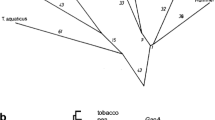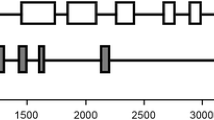Abstract
Chloroplast glyceraldehyde-3-phosphate dehydrogenase (GAPDH) is composed of two different subunits, GapA and GapB. cDNA clones containing the entire coding sequences of the cytosolic precursors for GapA from pea and for GapB from pea and spinach have been identified, sequenced and the derived amino acid sequences have been compared to the corresponding sequences from tobacco, maize and mustard. These comparisons show that GapB differs from GapA in about 20% of its amino acid residues and by the presence of a flexible and negatively charged C-terminal extension, possibly responsible for the observed association of the enzyme with chloroplast envelopes in vitro. This C-terminal extension (29 or 30 residues) may be susceptible to proteolytic cleavage thereby leading to a conversion of chloroplast GAPDH isoenzyme I into isoenzyme II. Evolutionary rate comparisons at the amino acid sequence level show that chloroplast GapA and GapB evolve roughly two-fold slower than their cytosolic counterpart GapC. GapA and GapB transit peptides evolve about 10 times faster than the corresponding mature subunits. They are relatively long (68 and 83 residues for pea GapA and spinach GapB respectively) and share a similar amino acid framework with other chloroplast transit peptides.
Similar content being viewed by others
References
Beisiegel U: Protein blotting. Electrophoresis 7: 1–18 (1986).
Benton WD, Davis RW: Screening λgt recombinant clones by hybridization to single plaques in situ. Science 196: 180–182 (1977).
Biesecker G, Harris JI, Thierry JC, Walker JE, Wonacott AJ: Sequence and structure of D-glyceraldehyde 3-phosphate dehydrogenase from Bacillus stearothermophilus. Nature 266: 328–333 (1977).
Brinkmann H, Martinez P, Quigley F, Martin W, Cerff R: Endosymbiotic origin and codon bias of the nuclear gene for chloroplast glyceraldehyde 3-phosphate dehydrogenase from maize. J Mol Evol 26: 320–328 (1987).
Cerff R: Glyceraldehyde-3-phosphate dehydrogenase (NADP) from Sinapis alba. NAD(P)-induced conformation changes of the enzyme. Eur J Biochem 82, 45–53 (1978).
Cerff R: Quaternary structure of higher plant glyceraldehyde-3-phosphate dehydrogenases. Eur J Biochem 94: 243–247 (1979).
Cerff R: Separation and purification of NAD- and NADP-linked glyceraldehyde-3-phosphate dehydrogenases from higher plants. In: Edelmann M, Hallick RB, Chua NH (eds) Methods in Chloroplast Molecular Biology, pp. 683–694. Elsevier Biomedical Press, Amsterdam (1982).
Cerff R, Chambers SE: Subunit structure of higher plant glyceraldehyde-3-phosphate dehydrogenases (EC 1.2.1.12 and EC 1.2.1.13). J Biol Chem 254: 6094–6098 (1979).
Cerff R, Kloppstech K: Structural diversity and differential light control of mRNAs coding for angiosperm glyceraldehyde-3-phosphate dehydrogenases. Proc Natl Acad Sci USA 79: 7624–7628 (1982).
Cerff R, Hundrieser J, Friedrich R: Subunit B of chloroplast glyceraldehyde-3-phosphate dehydrogenase is related to beta-tubulin. Mol Gen Genet 204: 44–51 (1986).
Conway T, Sewell GW, Ingram LO: Glyceraldehyde-3-phosphate dehydrogenase gene from Zymomonas mobilis: cloning sequencing and identification of promotor region. J Bacteriol 169: 5653–5662 (1987).
Chojecki J: Identification and characterization of a cDNA clone for cytosolic glyceraldehyde-3-phosphate dehydrogenase in barley. Carlsberg Res Commun 51: 203–210 (1986).
Dayhoff MO: Atlas of Protein Sequence and Structure, vol. 5, suppl. 3, p. 3. National Biochemical Research Foundation, Washington, DC (1978).
Douce R, Joyard J: Structure and function of the plastid envelope. Adv Bot Res 7: 1–116 (1979).
Dover GA, Flavell RB: Molecular coevolution: DNA divergence and the maintenance of function. Cell 38: 622–623 (1984).
Ferri G, Stoppini M, Iadarola P, Zapponi MC, Galliano M, Minchiotti L: Structural characterisation of the subunits of spinach chloroplast glyceraldehyde-3-phosphate dehydrogenase (NADP). Biochim Biophys Acta 915: 149–156 (1987).
Flügge UI, Fischer K, Gross A, Sebald W, Lottspeich F, Eckerskorn C: The triose phosphate-3-phosphoglycerate-phosphate translocator from spinach chloroplasts: nucleotide sequence of a full-length cDNA clone and import of the in vitro synthesized precursor protein into chloroplasts. EMBO J 8: 39–46 (1989).
Flügge UI, Heldt W: The phosphate-triosephosphate-phosphoglycerate translocator of the chloroplast. Trends Biochem Sci 9: 530–533 (1984).
Gubler U, Hoffman BJ: A simple and very efficient method for generating cDNA libraries. Gene 25: 263–269 (1983).
Harris JI, Waters M: Glyceraldehyde-3-phosphate dehydrogenase. In: Boyer PD (ed) The Enzymes, 3rd ed, vol. 13, pp. 1–48. Academic Press, New York (1976).
Jukes TH, Cantor CR: In: Munro HN (ed) Mammalian Protein Metabolism, pp. 21–123. Academic Press, New York (1969).
Karlin-Neumann G, Tobin EM: Transit peptides of nuclear encoded chloroplast proteins share a common amino acid framework. EMBO J 5: 9–13 (1986).
Laemmli OK: Cleavage of structural proteins during the assembly of the head of bacteriophage T4. Nature 227: 680–685 (1970).
Maniatis T, Hardison RC, Lacy E, Lauer J, O'Connell C, Quon D, Sim GK, Efstratiados A: The isolation of structural genes from libraries of eukaryotic DNA. Cell 15: 687–701 (1978).
Maniatis T, Fritsch EF, Sambrook G: Synthesis of cDNA. In: Molecular cloning; A laboratory manual, pp. 211–246. Cold Spring Harbor Laboratory Press, Cold Spring Harbor, NY (1982).
Martin W, Cerff R: Prokaryotic features of a nucleus-encoded enzyme. Eur J Biochem 159: 323–331 (1986).
Murray NE: Phage lambda and molecular cloning. In: Hendrix RW, Roberts JW, Stahl FW, Weisberg RA (eds) Lambda II, pp. 395–432. Cold Spring Harbor Laboratory Press, Cold Spring Harbor, NY (1983). Lambda II, pp. 395–432. Cold Spring Harbor Laboratory Press, Cold Spring Harbor, NY (1983).
Rossmann MG, Liljas A, Bränden CJ, Banaszak J: Evolutionary and structural relationships among dehydrogenases. In: Boyer PD (ed) The Enzymes, 3rd edn, vol. 11, pp. 61–102. Academic Press, New York (1975).
Sanger F, Nickler S, Coulson AR: DNA sequencing with chain-termination inhibitors. Proc Natl Acad Sci USA 74: 5463–5467 (1977).
Scherer G, Telford J, Baldari C, Pirrotta V: Dev Biol 86: 438–447 (1981).
Schmidt GW, Mishkind ML: The transport of proteins into chloroplasts. Ann Rev Biochem 55: 879–912 (1986).
Shih MC, Lazar G, Goodman HM: Evidence in favor of the symbiotic origin of chloroplasts: primary structure and evolution of tobacco glyceraldehyde-3-phosphate dehydrogenases. Cell 47: 73–80 (1986).
Skarzynski T, Moody PCE, Wonacott AJ: Structure of the hologlyceraldehyde-3-phosphate dehydrogenase from Bacillus stearothermophilus at 1,8 Å resolution. J. Mol Biol 193: 171–187 (1987).
Tittgen J, Hermans J, Steppuhn J, Jansen T, Jansson C, Andersson B, Nechushtai R, Nelson N, Herrmann C: Isolation of cDNA clones for fourteen nuclear-encoded hylakoid membrane proteins. Mol Gen Genet 204: 258–265 (1986).
VonHeijne G: A new method for predicting signal sequence cleavage sites. Nucl Acids Res 14, 4683–4690 (1986).
Von Heijne G, Stepphuhn J, Herrmann RG: Domain structure of mitochondrial and chloroplast targeting peptides. Eur J Biochem, in press.
Young RA, Davis RW: Yeast RNA polymerase II genes: isolation with antibody probes. Science 222: 778–782 (1983).
Author information
Authors and Affiliations
Rights and permissions
About this article
Cite this article
Brinkmann, H., Cerff, R., Salomon, M. et al. Cloning and sequence analysis of cDNAs encoding the cytosolic precursors of subunits GapA and GapB of chloroplast glyceraldehyde-3-phosphate dehydrogenase from pea and spinach. Plant Mol Biol 13, 81–94 (1989). https://doi.org/10.1007/BF00027337
Received:
Accepted:
Issue Date:
DOI: https://doi.org/10.1007/BF00027337




